#thefirststar
Text
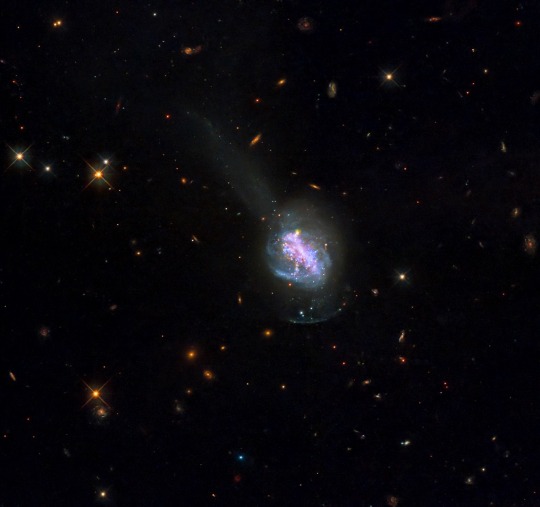
This new NASA Hubble Space Telescope image shows ESO 185-IG013, a luminous blue compact galaxy (BCG). BCGs are nearby galaxies that show an intense burst of star formation. They are unusually blue in visible light, which sets them apart from other high-starburst galaxies that emit more infrared light.
Image Credit & Copyright: NASA, ESA, and R. Chandar (University of Toledo); Processing: Gladys Kober (NASA/Catholic University of America)
#astronomy#space#science#universe#galaxy#blue compact galaxy#compact galaxy#blue compact#Hubble#hubble space telescope#high starburst#starburst#starburst galaxy#blue light#follow#like#reblog#the first star#the first starr#thefirststar#thefirststarr#nasa#apod#tumblr#blog#space blogger#space blog
151 notes
·
View notes
Photo

一番星( the first star of evening))
Oct. 8,2020
watercolor
size:242*333mm (F4)
paper:water ford white (細目・300g/m2)
***
喜びを数えたら、あなたでいっぱい。
257 notes
·
View notes
Photo

181106 Genie Music Awards
© TheFirstStar | Do not edit.
45 notes
·
View notes
Photo
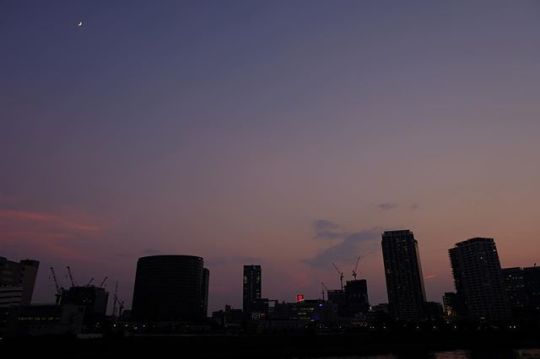
#evening with #thefirststar — view on Instagram https://ift.tt/2P3zd4w
1 note
·
View note
Text
THE FIRST STAR
This piece is part of a children’s book called Unfinished Bedtime Stories that puts you in the shoes of the protagonist. It sets up the world and the character, but lets your imagination do the rest. Read this before you go to sleep.
You are lying in your cozy bed. Your mom and dad kiss you goodnight and leave the room. As their footsteps disappear down the hallway, you can hear the crickets chirping in the hills outside your window. You open your eyes and watch the doorway. The light at the end of the hallway flicks off. Your parents are going to sleep. It’s safe now.
You slip out of bed, as quiet as a mouse, and drag your telescope over to your window. You point your telescope toward the stars and wait. All the newspapers said that it would happen tonight. Then you see it. The first flash of silver streaks across the darkness. It’s a shooting star. Then there’s another and another and the meteor shower begins. You watch with wide eyes. It’s beautiful.
Then a giant star unlike the others appears and rockets across the sky, but instead of growing smaller and dimmer, it grows bigger and brighter, so big and bright that you have to back away from your telescope. It begins to fall. It's falling down, falling towards you, you think, and then, for a moment, it lights up the whole night sky before it disappears in the hills. You stare out at the hills. They're close. You ride your bike in them every day. Did a shooting star just land there?
You’re going to find out and you’re not going to waste anytime. You grab a sweatshirt and climb out your window onto the roof of the second story. You carefully step across the clay tiles to a branch of the big tree in your front yard. You’ve done this before. You step out onto the branch, grab another branch for support and tightrope walk your way to the trunk where you scurry down to the grass. The grass is cold and damp on your bare feet and that’s when you realize that you forgot your shoes! It’s too late to go back now.
You grab your bike from the front porch and wheel it silently out the front gate and onto the path that leads into the hills. You hop on your bike and peddle. Slowly and quietly at first, then faster and faster until you are racing through the dark green hills, up and down and around the windy trail. Finally you reach the spot where you think it disappeared, but you don’t see anything. Maybe you were wrong, you think.
You are about to give up and head back when you notice a faint glow behind the hill in front of you. You drop your bike and race across the grass until you come to…
...a cliff! You stop just in time. On the other side of the hill, is a dirt cliff at the edge of a giant crater. And at the center of the crater, is a tiny glowing sphere of light. It’s a star. So that's what a star looks like, like a light bulb floating in space.
Without thinking, you scramble down the rocky cliffside and go tumbling into the crater. You spring to your feet and run to the star. You slow down as you get closer. It looks like a bright, white ball of light. It’s brightest at the center and then it sort of fades off.
You reach out to touch it and, as your fingers enter the first particles of light, you feel a tingling sensation. It tickles. You smile and reach deeper into the light. You cup your palm underneath it and now you are holding the star in your hands. Then it begins to shrink, as if it’s melting into your hands. Your whole body tickles. It feels good. It feels amazing. It gets smaller and smaller until POP! It disappears.
You stand there looking at your empty hands wondering what happened. You have a new energy. You feel happy and energetic, like you want to run and jump and climb and fly. You run to the edge of the crater and try to climb up but some of the dirt breaks loose and you fall back down. You didn't realize how steep it was when you climbed down. Now you're stuck.
You try to climb again and again but the dirt keeps breaking away and you keep falling. Frustrated, you finally leap as high as you can and suddenly you are launched into the air, up and out of the crater. You land onto the soft grass and go rolling all the way down the hill. You stand up. Holy cow. What just happened?
You try jumping again and you fly high into the air, as high as a house, higher than you've ever jumped before. This is cool! You grab rock and throw it in the air. Then you jump and you catch it high up, twenty feet above the ground. You throw it again, but this time it's out of reach. You focus your mind on catching it and suddenly you are floating and you catch the rock. But as soon as you realize that you're floating, you crash to the ground giggling. If you focus, you might be able to learn to fly!
You'd better get home before your parents discover that you're missing. You bike home and peddle faster than you've ever gone. You lock up your bike, bend your legs, and spring onto the roof in a single leap! You land with a CRASH on the clay tiles. Your parents will have heard that. You race back into your room and, thinking quickly, you set the telescope on its side. You are about to jump into bed when you see the hall light flip on and hear footsteps pound towards you. It's your mom. She's going to catch you. If only you could make yourself invisible!
Your mom bursts into the room and stops. She scans the room, “Sweetie? Where are you?” You're standing right in front of her, but she can't see you. You ARE invisible! She moves to the window and closes it. You jump into bed and pull the sheets back over you. Ok, now you don't want to be invisible, you think. Your mom turns back from the window and jumps and screams! She's staring right at you now.
“I didn't see you there! It's so dark in here.”
You roll over and rub your eyes, pretending to be half asleep.
“Sorry…”
“Did you open the window?”
“Yeah, I got hot.”
“What was that noise?”
You yawn groggily, “I knocked over my telescope, sorry.”
She looks over and sees the telescope on its side.
“It's ok, get some sleep.” Your mom tucks you in, fixes the telescope and leaves.
You snuggle into your warm sheets with a smile and dream of what you'll do with your super powers in the morning.
0 notes
Text

The total solar eclipse seen in Dallas, Texas on Monday, April 8, 2024!! A total solar eclipse swept across a narrow portion of the North American continent from Mexico’s Pacific coast to the Atlantic coast of Newfoundland, Canada. A partial solar eclipse was visible across the entire North American continent along with parts of Central America and Europe.
Was anyone able to see it?
Image Credit & Copyright: NASA/Keegan Barber
#astronomy#space#science#universe#total solar eclipse#solar eclipse#eclipse#solar#sun#moon#Canada#Mexico#USA#partial eclipse#solar eclipse 2024#follow#like#reblog#the first star#the first starr#thefirststar#thefirststarr#nasa#apod#tumblr#blog
113 notes
·
View notes
Text
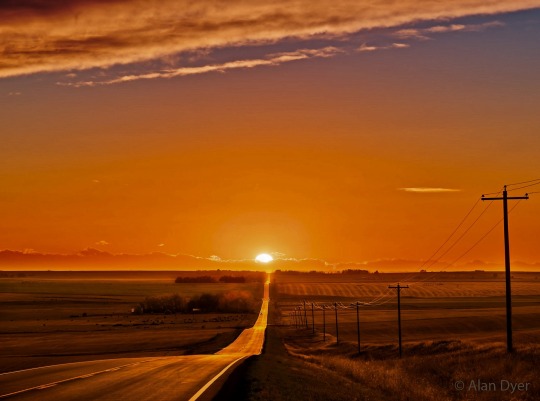
What's that at the end of the road? The Sun. Many towns have roads that run east-west, and on two days each year, the Sun rises and sets right down the middle. Yesterday, in some parts of the world (today in others), is one of those days: an equinox. Not only is this a day of equal night and day time, but also a day when the sun rises precisely to the east and sets due west. Displayed here is a picturesque rural road in Alberta, Canada that runs approximately east-west. The featured image was taken during the September Equinox of 2021, but the geometry remains the same every year. In many cultures, this March equinox is taken to be the first day of a season, typically spring in Earth's northern hemisphere, and autumn in the south.
Image Credit & Copyright: Alan Dyer, Amazingsky.com, TWAN
#astronomy#space#science#universe#equinox#vernal equinox#spring#first day of spring#spring equinox#sun#east#west#sun set#Sun rise#sunset#sunrise#follow#like#reblog#the first star#the first starr#thefirststar#thefirststarr#nasa#apod#hemisphere#seasons#autumn#autum equinox#autumnal equinox
84 notes
·
View notes
Text

SPACEMAS DAY 25 ✨🪐🌎☄️☀️🌕
MERRY CHRISTMAS!!!! These last 25 days have been so fun! Thank you for coming along with me!!
Majestic on a cosmic scale, M100 is known as a grand design spiral galaxy. It’s a large galaxy of over 100 billion stars with well-defined spiral arms that is similar to the Milky Way Galaxy. Also one of the brightest members of the Virgo Cluster of galaxies, M100 (aka NGC 4321) is 56 million light-years away toward the constellation of Berenice's Hair (Coma Berenices). This Hubble Space Telescope image of M100 was taken with the Wide Field Camera 3 and accentuates bright blue star clusters and intricate winding dust lanes which are hallmarks of this class of galaxies. Studies of variable stars in M100 have played an important role in determining the size and age of the Universe.
Image Credit & Copyright: NASA, ESA, Hubble
#astronomy#space#science#universe#spacemas#day 25#christmas#merry christmas#galaxy#Virgo cluster#Milky Way#spiral#spiral galaxy#follow#like#reblog#the first star#the first starr#thefirststar#thefirststarr#nasa#apod#tumblr#blog#tumblr blog#space blog
92 notes
·
View notes
Text

SPACEMAS DAY 14 ✨🪐🌎☄️☀️🌕
Most galaxies don't have any rings of stars and gas but why does M94 have two? First, spiral galaxy M94 has an inner ring of newly formed stars surrounding its nucleus, giving it not only an unusual appearance but also a strong interior glow. A leading hypothesis states that there’s an elongated knot of stars known as a bar, and it rotates in M94. This has generated a burst of star formation in this inner ring. Observations have also revealed another ring, an outer ring. This one is more faint, different in color, not closed, and relatively complex. What caused this outer ring to form is currently unknown. M94, pictured here, spans about 45,000 light years in total, lies about 15 million light years away, and can be seen with a small telescope toward the constellation of the Hunting Dogs (Canes Venatici).
Image Credit & Copyright: Brian Brennan
#astronomy#space#science#universe#spacemas#day 14#galaxy#spiral#double ring#ring#bar#new stars#spiral galaxy#unknown#follow#like#reblog#the first star#the first starr#thefirststar#thefirststarr#nasa#apod#tumblr#blog#space blog#space tumblr
86 notes
·
View notes
Text

SPACEMAS DAY 24 ✨🪐🌎☄️☀️🌕
Merry Christmas Eve everyone 🎄🎅🏻☃️❄️🥰
Formed within the nebula cataloged as NGC 281, are the stars of open cluster IC 1590. The cluster's young, massive stars ultimately power the pervasive nebular glow. The eye-catching shapes looming in the featured portrait of NGC 281 are sculpted dusty columns and dense globules seen in silhouette, eroded by intense, energetic winds and radiation from the hot cluster stars. If they survive long enough, the dusty structures could also be sites of future star formation. Called the Pacman Nebula because of its overall shape, NGC 281 is about 10,000 light-years away in the constellation Cassiopeia. This sharp composite image was made through narrow-band filters. It combines emission from the nebula's hydrogen and oxygen atoms to synthesize red, green, and blue colors. The scene spans well over 80 light-years.
Image Credit & Copyright: Craig Stocks
#astronomy#space#science#universe#spacemas#day 24#cassiopeia#nebula#star cluster#light year#stars#nebular glow#Pac-Man#Pac-Man nebula#follow#like#reblog#the first star#the first starr#thefirststar#thefirststarr#nasa#apod#tumblr#blog#space blog#constellation#Christmas Eve#merry Christmas
76 notes
·
View notes
Text

Boom!! There goes another one! One of Jupiters many moons, Io, is about the size of Earth's moon, but its surface is full of volcanic activity. This is due to gravitational flexing by Jupiter and other moons. The process heats the moons interior, covering the surface with volcanoes. The featured image is from NASA’s robotic June spacecrafts fly by last week, passing within 12,000 kilometers above the dangerously active world. The surface of Io is covered with sulfur and frozen sulfur dioxide, making it appear yellow, orange and brown. As hoped, Juno flew by just as a volcano was erupting -- with its faint plume visible near the top of the featured image. Studying Io's volcanoes and plumes helps scientists better understand how Jupiter's complex system of moons, rings, and auroras interact. Juno is scheduled to make two flybys of Io during the coming months that are almost 10 times closer: one in December and another in February 2024.
Image credit: NASA
#astronomy#space#science#universe#moon#jupiter#io#jupiter moon#volcano#volcanic activity#erupt#eruption#sulfur#surface#mystery#dangerous#follow#like#reblog#thefirststar#thefirststarr#the first star#the first starr#blog#tumblr#space blog#cool#pretty#colours#wow
86 notes
·
View notes
Text
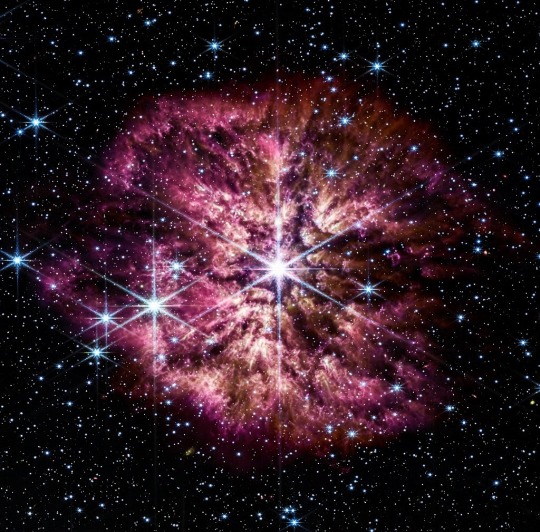
SPACEMAS DAY 9 ✨🪐🌎☄️☀️🌕
Driven by powerful stellar winds, the expanding gas and dust frame the hot, luminous star Wolf-Rayet 124 in this sharp infrared view. The 6-spike star pattern is characteristic, taken with the 18 hexagonal mirrors of the James Webb Space Telescope. About 15,000 light-years away toward the pointed northern constellation Sagittarius, WR 124 has over 30 times the mass of the Sun. Produced in a brief and rarely spotted phase of massive star evolution in the Milky Way, this star's turbulent nebula is nearly 6 light-years across. WR 124's impending stellar death will be a supernova explosion and any dusty interstellar debris that survives the supernova will influence the formation of future generations of stars.
Image Credit: NASA
#astronomy#space#science#universe#spacemas#day 9#nebula#star#supernova#jwst#james webb space telescope#follow#like#reblog#the first star#the first starr#thefirststar#thefirststarr#nasa#apod#tumblr#blog#space blog
74 notes
·
View notes
Text

On September 12, just south of the Arctic Circle, stones of Iceland's modern Arctic Henge point skyward. During a geomagnetic storm, the northern lights appear across the darkened sky while a stunning fireball meteor explodes. The trail was seen for minutes wafting in the upper atmosphere at altitudes of 60 to 90 kilometers along with the auroral glow.
Image Credit & Copyright: Jennifer Franklin
#astronomy#space#science#universe#meteor#comet#northern lights#northern#lights#glow#Arctic Ocean#arctic#ocean#follow#like#reblog#the first starr#thefirststarr#thefirststar#the first star#nasa#apod#tumblr#blog
114 notes
·
View notes
Text
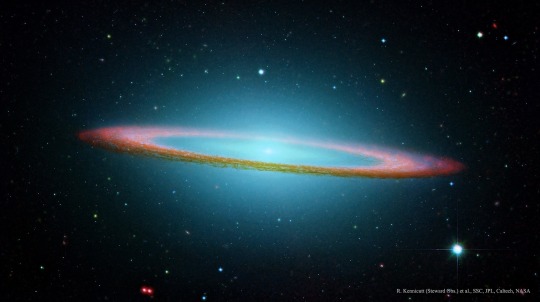
This floating ring is the size of a galaxy. In fact, it is a galaxy or at least part of one. The Sombrero Galaxy is one of the largest galaxies in the nearby Virgo Cluster of Galaxies. The dark band of dust that obscures the mid-section of the Sombrero Galaxy in visible light glows bright in this infrared light image. The image, digitally sharpened, shows the infrared glow, recently recorded by the orbiting Spitzer Space Telescope, superposed in false-color on an existing image taken by NASA's Hubble Space Telescope in visible light.
The Sombrero Galaxy, also known as M104, spans about 50,000 light years across and lies 28 million light years away. M104 can be seen with a small telescope in the direction of the constellation Virgo.
Credit: R. Kennicutt (Steward Obs.) et al., SSC, JPL, Caltech, NASA
#astronomy#space#science#universe#galaxy#sombrero#sombrero galaxy#infrared#infrared light#Virgo#Virgo cluster#cluster#follow#like#reblog#the first star#the first starr#thefirststar#thefirststarr#nasa#apod#tumblr#blog
122 notes
·
View notes